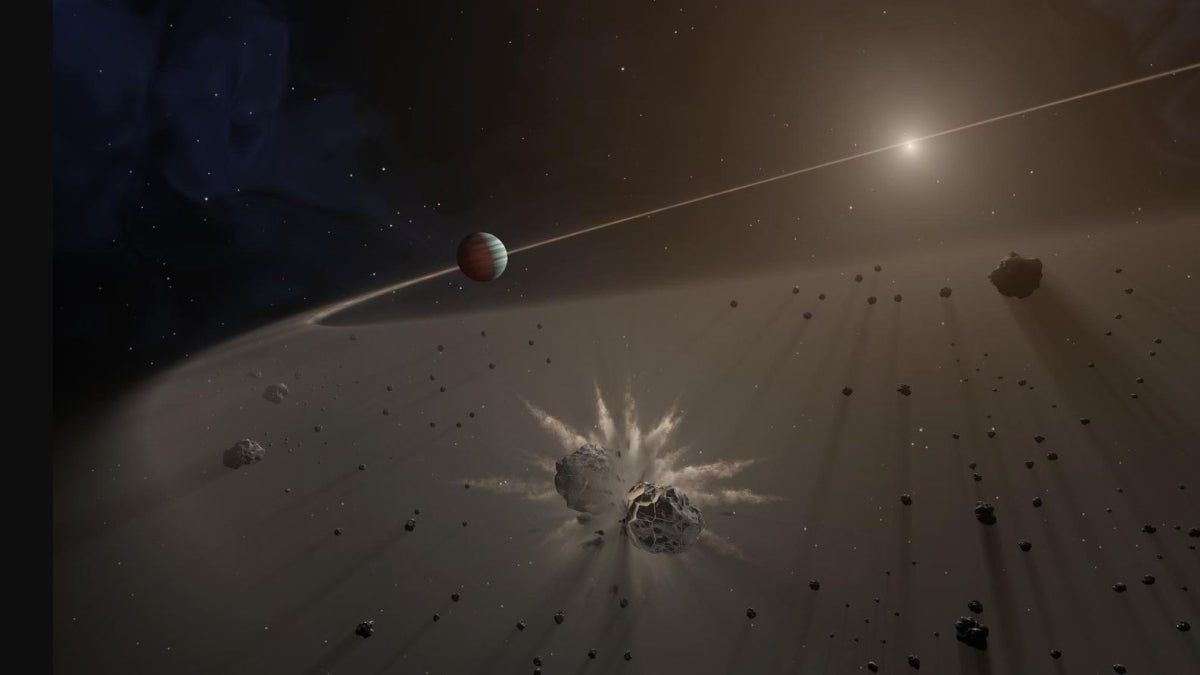The case of the missing mantle

Debris from planet-forming collisions can range from solid materials to gases. The work from Gabriel & Allen-Sutter (2021) suggests large collisions form predominantly gas, leaving behind little trace in the current solar system. Illustration credit: NASA/JPL-Caltech
In the early solar system, terrestrial planets like Mercury, Venus, Earth and Mars are thought to have formed from planetesimals, small early planets. These early planets grew over time, through collisions and mergers, to make them the size they are today.
The material released from these violent collisions is commonly thought to have escaped and orbited around the sun, bombarding the growing planets and altering the composition of the asteroid belt. But the asteroid belt does not seem to contain a record of this impact debris, which is a mystery that has been stumping astronomers and astrophysicists for decades.
Two researchers from Arizona State University’s School of Earth and Space Exploration, former NewSpace Postdoctoral Fellow Travis Gabriel and doctoral student Harrison Allen-Sutter, were curious about this discrepancy and set about creating high-end computer simulations of the collisions, with surprising results.
“Most researchers focus on the direct effects of impacts, but the nature of the debris has been underexplored,” Allen-Sutter said.
Instead of creating rocky debris, the simulations showed that large collisions between planets vaporize the rocks into gas. Unlike solid and molten debris, this gas more easily escapes the solar system, leaving little trace of these planet-smashing events.
Their work, which has been published in the Astrophysical Journal Letters, provides a potential solution to this decades-old paradox, dubbed the "Missing Mantle Problem" or the "Great Dunite Shortage."
“It has long since been understood that numerous large collisions are required to form Mercury, Venus, Earth, the moon and perhaps Mars,” said Gabriel, who is the principal investigator of this project. “But the tremendous amount of impact debris expected from this process is not observed in the asteroid belt, so it has always been a paradoxical situation.”
Their results may also help us to better understand how the moon was formed, which is thought to have been born from the aftermath of a collision that released debris into the solar system.
“After forming from debris bound to the Earth, the moon would have also been bombarded by the ejected material that orbits the sun over the first hundred million years or so of the moon’s existence,” Gabriel said. “If this debris was solid, it could compromise or strongly influence the moon's early formation, especially if the collision was violent. If the material was in gas form, however, the debris may not have influenced the early moon at all.”
Gabriel and Allen-Sutter hope to continue this line of research to learn more about not only our own planets, but also the large population of planets observed outside our solar system.
“There is growing evidence that certain telescope observations may have directly imaged giant impact debris around other stars,” Gabriel said. “Since we cannot go back in time to observe the collisions in our solar system, these astrophysical observations of other worlds are a natural laboratory for us to test and explore our theory.”
More Science and technology

ASU postdoctoral researcher leads initiative to support graduate student mental health
Olivia Davis had firsthand experience with anxiety and OCD before she entered grad school. Then, during the pandemic and as a…

ASU graduate student researching interplay between family dynamics, ADHD
The symptoms of attention deficit hyperactivity disorder (ADHD) — which include daydreaming, making careless mistakes or taking…

Will this antibiotic work? ASU scientists develop rapid bacterial tests
Bacteria multiply at an astonishing rate, sometimes doubling in number in under four minutes. Imagine a doctor faced with a…